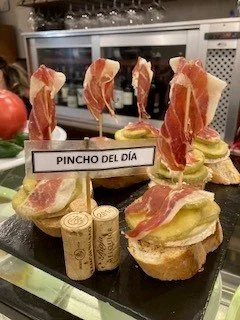Wine Touring in Rioja
Earlier this year, I had the opportunity to visit the Rioja (ree-OH-huh) wine region in north central Spain. I have been a longtime cheerleader for this region but hadn’t visited the area since 2010 so I was overdue for a refresh. I flew directly from Calgary to Barcelona, and then took the train to Logroño. I enjoy train travel in Europe, so whenever I can, I will opt to travel this way.
Spain’s Pioneer Wine Region
The Rioja wine region is the oldest and most famous wine region in Spain. If you only know one wine region in Spain, it is likely Rioja! It has a long winemaking history dating back to 11 century BC. The region gets its name from the Oja River or “Rio Oja” in Spanish. It is one of the tributaries of the much longer Ebro River that flows through the region cutting it in half from north to south. Mountains surround the region from north to south acting as a fortress of protection against the elements.
The Rioja wine region encompasses three autonomous regions – La Rioja, Basque Country and Navarra. A large and diverse region, it stretches 100 kilometres from east to west, and 40 kilometres from north to south. Wines come in a variety of styles from red, white, rose (rosado in Spanish) to sparkling. As of 2023, there are 578 wineries, with 204 of them open to the public.
The Rioja wine region is divided into three sub-zones – Rioja Alta, Rioja Alavesa and Rioja Oriental. The variation in climate from the Rioja Oriental in the east to Rioja Alavesa and Rioja Alta in the west, has a major effect on the wines. Consumers benefit because they get to explore a diversity of distinctive terroirs without having to leave the Rioja region.
Map compliments of Rioja Wine Academy
Rioja is red wine country. 83% of production is red wine leaving the remaining 17% divided into 11% white and 6% rose (2023 figures). Tempranillo is the flagship red grape and is the most widely planted in the region. Temprano means early in Spanish so it’s fitting that it’s a grape that buds and ripens early. Tempranillo is one of the nine red noble grapes and is an old variety. It is native to the region and grows well in the different microclimates. Including Tempranillo, there are 14 permitted grape varieties allowed to be grown in the region – five red and nine white, with Viura being the most important white variety. Three of the grape varieties are extremely rare so if you see them, I highly recommend you try them. They are Maturana Tinta (red), Maturana Blanca (white – oldest variety) and Turruntes (white).
To appreciate Rioja wine, it is critical to understand its relationship with oak ageing. Introduced by French winemakers in the late 1800’s, barrel ageing continues to play a key role. The wines are divided by categories of oak ageing and by origin. Wines fall into one of the four traditional categories of Cosecha, Crianza, Reserva and Gran Reserva. The amount of time the wine is aged in the bottle and in oak barrels depends on the category level. Only sparkling and Consecha wines are not required to spend a minimum time in oak barrels. The extended ageing both in oak and in the bottle mean that the wines are ready to drink upon release.
Planning Your Trip
When organizing a tour, whether for a larger group or oneself, the first question to address is the length of your stay. To do this fantastic region justice, I would recommend at least 3 full days to explore. If possible, consider extending that to 5 days in order to adjust to the Spanish ‘tempo’ and give yourself a chance to take in one of the many cultural events happening throughout the year.
From left to right: Pincho of the Day and the bustling Calle de Laurel Street on a Saturday afternoon
The city of Logroño makes a good home base as it is a pretty city of 150,000 people that is easy to navigate. I suggest staying in the old town, near Calle de Laurel as this small street is famous for its tapas (or as they call it ‘Pintxos’) bars. Spend an evening going tapas bar hopping. You won’t regret it – it’s so much fun! One tip though is not to go too early. You may beat the lines but you will miss the true Spanish experience!
Plan to dedicate one day to each sub-zone – Rioja Alta, Rioja Alavesa and Rioja Oriental. If staying longer than 3 days, you can go at a more leisurely pace and include a visit to a monastery or stay at a winery. When I was visiting, I went to the SUSO (meaning upper) and YUSO (meaning lower) monasteries in the town of San Millán de la Cogolla. Not only are they UNESCO World Heritage Sites but also the birthplace of Castilian Spanish language. I took a tour of both monasteries and stayed one night at the Hosteria San Milan.
If you are planning your own tour, I recommend checking out the Wines of Rioja for itinerary recommendations and winery information. They offer valuable suggestions whether you are travelling alone, in a couple, or in a group. Be sure to check out their suggested wine routes called Ruta Del Vino when you are planning your visit. The website is full of current and sub-zone specific information that will make planning your visit much easier.
Minimum Stay is 3 Days
Staying in Logroño, provides easy access to all three sub-zones. You can choose to return to Logroño each night or book accommodation in each sub-zone. The order you choose to tour is completely up to you. This is the order that I toured the region.
Day 1 – Rioja Oriental
Rioja Oriental lies east of Logroño. It is the warmest of the three sub-zones due to the influence of the Mediterranean Sea. If time permits, try and visit the town of Alfaro in the far east as this is where you will find the highest elevation vineyards at the base of Mount Yerga. At 700 meters (2300 feet), Mount Yerga forms the eastern boundary of the Rioja region.
Grape Specialty
Garnacha thrives here due to the heat of this region, especially near Mount Yerga. Take a look for it growing on short bush vines (shown above).
I also really like the Tempranillo Blanco.
Winery visit suggestions
From left to right: Ilurce Garnacha made from 50 year old vines, winemaker Carlos Mazo of Vinos en Voz Baja and winemaker Clara Herrero of Finca Vistahermosa
Day 2 – Rioja Alta
The city of Logroño is in the Rioja Alta sub-zone. Most of Rioja Alta lies to the south of the Ebro River and west of Logroño. The terrain is mainly flat accentuated by terraces and small hills. It is colder than the rest of the Rioja region due to the influence of the Atlantic Ocean. Temperature swings between day and night are also greater which is reflected in the acidity of the wines.
The town of Haro is the historical capital of Rioja. Every year at the end of June, the town hosts a wine festival known as La Battalla del Vino de Haro (The Haro Wine Fight). In a tradition dating back to the 6th century, attendees dress up in red or white, and once the Mayor signals his permission, they go to battle throwing wine at each other!
Grape Specialty
Tempranillo
You must try – Garnacha, Mazuelo, Graciano, Viura, Malvasia, Tempranillo Blanco and Maturana Blanca.
Winery visit suggestions
Barrio de la Estacion (Railway Station district in Haro) - there are several renowned wineries conveniently located in one place.
Interesting fact – Haro is home to the highest concentration of century old wineries in the world!
From left to right: underground cellars at Campo Viejo, Bodegas Muga, Bodegas Nivarius winemaker Rafael Garcia and Lopez de Heredia Vina Tondonia
Other places to add if time permits:
Vivanco Museum of the Culture of Wine
SUSO and YUSO monasteries in San Millán dee la Cogolla.
Day 3 – Rioja Alavesa
Rioja Alavesa is located in Basque Country. It lies between the Ebro River and the Sierra de Cantabria Mountain Range which help protect it from the cold winds off the Bay of Biscay. Rioja Alavesa has a long viticultural history dating back to the Middle Ages thanks to its sunny, dry climate ideal for growing grapes.
Make it stand out
Whatever it is, the way you tell your story online can make all the difference.
There are two ‘must sees’ in this zone. First, the charming village of Laguardia, a 20 minute drive from Logroño. Perched upon a hill overlooking vineyards, Laguardia is a pedestrian village that has retained its medieval character. Second, just down the road is the quaint town of Elciego, home to some of the most renowned wineries in the region – known not only for their wines but for their architecture as well. Get ready to see avant-garde wineries designed by famous architects – Marques de Riscal by Frank Gehry, Ysios by Santiago Calatrava and Bodegas Baigorri by Iñaki Aspiazu Iza.
Grape Specialty
Tempranillo dominates here.
Also keep your eyes out for Graciano, Mazuelo, Viura and Malvasia.
Winery visit suggestions
From left to right: Selection of wines at Bodega Bideona, Marques de Riscal Hotel by Frank Gehry, and Remirez de Ganuza winery
Put Rioja on Your Bucket List
Rioja is a special place and deserves to be on any wine lover’s bucket list. I enjoyed visiting both the historical and modern Rioja wineries. I have always been a big fan of Tempranillo. That hasn’t changed, but this trip has given me a greater appreciation of the white wines and the new classification of origin wines.
I also couldn’t wait to see Frank Gehry’s Marques de Riscal Hotel. It was as cool as I had imagined and such a contrast to the rest of the winery. If you want a splurge, plan ahead and stay there. Make sure to also put a visit to the Vivanco Museum of Wine Culture on your list. To do this museum justice, you need to spend at least 3 hours but I would highly recommend that as I think it is the best wine museum that I have ever been to.
Getting to Logroño is fairly straight forward from Bilbao, Madrid or Barcelona. As to what time of year to go, that depends on what you are looking for. I went in late May and the weather was lovely. There had been a lot of rain earlier in the month but magically it cleared up in time for my stay. September and October would be nice too. However, I wouldn’t recommend going in July or August unless you love really hot weather.
Whenever you choose to go, Rioja is well worth any wine lover’s visit. A fascinating mixture of traditional and modern, this region has something for anyone. If before your trip, you would like to prepare and learn more about this historic wine region, I recommend the free courses by the Rioja Wine Academy. Their Rioja Enthusiast course is a good place to start to begin to understand the lay of the land. They also offer more advanced courses.


















